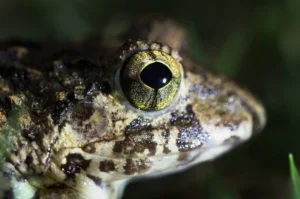Most frog species are nocturnal, which means they are most active at night. They have developed several adaptations to suit this lifestyle, and one of them is night vision.
Frogs can see in the dark because the structure of their eyes, and specifically their retinas, permits them better vision than humans when light levels are low. Their night vision is thought to be superior to all other animals, and they can see color even in extreme darkness, where humans are not able to see anything.
The positioning of frogs’ eyes atop the head, gives them a very wide range of vision. They can see in front, to the sides, and partially behind them.
This peripheral vision, along with excellent night vision, helps frogs to spot predators and search for food in low-light conditions.
Frog Eye Anatomy
Eyes can have many different forms, and their shape can also vary among different animal species.
Amphibians are unusual because their eyes have adapted very differently from other living vertebrates. The differences begin with the structure of the retina.

The retina is the light-sensitive portion of the eye. This structure is located in the back of the inside of the eyeball – and in most vertebrates (including humans), contains two types of light-sensitive cells, called rods and cones.
Cones are responsible for color vision – and are the receptors that respond to light, while rods are the receptors that respond to motion.
Because of this, cones need a lot more light to fire and send a signal to the brain, and therefore stop working when it gets dark.
This is the reason that you cannot distinguish between different colors in the dark. In fact, your night vision is almost entirely black and white.
Rods are the reason we can see in low-light conditions. They detect low levels of light which makes them ideal for providing vision in dim conditions.
Frogs and toads are unique in having rods with two different sensitivities.
This has not been found in other vertebrates and led researchers to suspect that frogs and toads might have a special ability to use their rods to distinguish color at very low light levels.
A recent study by researchers from Lund University in Sweden found evidence proving this to be true.
The Frog Night Vision Experiments
The researchers studied frogs and toads in a common situation the animals often find themselves in – navigating their way out when trapped in conditions of complete darkness.
This happens fairly commonly, as frogs and toads often find themselves in dark dens and passageways where they need to find an exit quickly.
Further experiments studied the extent to which frogs and toads use their color vision when looking for a mate or hunting for prey.
It was found that frogs and toads also use their excellent night vision when hunting for food in such low-light conditions that humans lose their ability to see color. However, they don’t tend to use it when searching for a mate.
Why Do Frogs Have Such Exceptional Night Vision?
As earlier mentioned, most frogs are primarily nocturnal creatures, so their adaptations for night vision are a direct result of their need to interact with their environment.
A nocturnal lifestyle is advantageous to frogs, and many other animals. The conditions at night provide the perfect environment for male frogs to come out of their daytime retreats.
Many of the animals that prey on frogs are less active at night, making it safer for frogs to come out and search for food.
For example, many predatory bird species such as hawks, and eagles are strictly diurnal, meaning they don’t hunt at night.
While there are also predators at night, frogs can blend into their environments easier and have a better chance of going unnoticed in the cover that the darkness provides.

Night life can also be beneficial for frogs because there’s less competition for resources. Fewer creatures are looking for a drink of water or on the hunt for prey at night, which means frogs have a better chance at success.
Furthermore, many of the insects that frogs prey on, such as crickets, are usually active at night, remaining hidden during the day. This means nighttime is a good time for hunting.
Lastly, frogs are ectothermic (cold-blooded) animals, which means they cannot regulate their body temperature. Their body temperature changes with that of their surroundings.
Many frog species hide in cool places during the day to avoid the hot temperatures.
Night temperatures are usually cooler because the sun is not out at night. The ground cools because it emits more radiation than it gains from the atmosphere.
This means frogs can come out and be more active without the fear of overheating.
Do All Frogs Have Great Vision?
Most frog species develop in two distinct life stages. They start their lives as fully aquatic tadpoles, and over time, develop and metamorph into frogs.
For this reason, frogs have evolved to live, and see in, two very different environments.
As tadpoles, the lens of the eye (also called the crystalline lens) is round, much like a fish. During metamorphosis, the lens changes into an oval shape more similar to the lens of other terrestrial animals.
However, even as adults, many frog species are semi-aquatic, meaning they regularly live in both terrestrial and aquatic habitats and must see in air and water.
Frogs have developed a wide range of adaptations to live in the water, and on land but even that is not enough to see well in both environments.
Since, water is denser than air, its refractive index is greater than that of air.

For this reason, most frog species are myopic (near-sighted) above water, and hyperoptic (farsighted) under water.
For humans, the opposite is true. We are extremely near-sighted underwater and are capable of seeing incredible distances on land.
The Dark of Night Actually Isn’t All That Dark
What often feels like complete darkness to us, really isn’t. Most of the time when it’s “dark”, there are actually some sources of light around, whether that’s the moon, streetlights, or even people’s porch and patio lights.
Even on the darkest nights, tiny bits of light are present.
Animals with night vision evolved to see in low-light conditions, so they have special adaptations that allow them to make the most of these very low levels of light to see movement and objects around them.
However, if there’s absolutely no light at all, then frogs (and other animals with night vision) would not be able to see – because eyes require light to function.
The reason we can see things like trees, rocks, and other objects is because light (either natural light or artificial light) bounces off them and hits the cornea of our eyes.
The pupil, which sits behind the cornea, then lets some of that light in, which continues moving to the back of the eye and into the retina.
In the retina, there are photoreceptors (which literally means “light receiver”). In most vertebrates, these photoreceptors are the rods and cones, which we earlier talked about.
The photoreceptors turn the light into electrical signals. These signals travel through the optic nerve to the brain which converts those signals into the “images” we see.
Sources:
Yovanovich, C. A. M., Koskela, S., Nevala, N. E., Kondrashev, S. L., Kelber, A., Donner, K. (2017). The Dual Rod System Of Amphibians Supports Colour Discrimination At the Absolute Visual Threshold. Phil. Trans. R. Soc. B, 1717(372), 20160066. https://doi.org/10.1098/rstb.2016.0066
Kelber, A., Yovanovich, C. A. M., Olsson, P. (2017). Thresholds and Noise Limitations Of Colour Vision In Dim Light. Phil. Trans. R. Soc. B, 1717(372), 20160065. https://doi.org/10.1098/rstb.2016.0065
Mitra, A. T., Womack, M. C., Gower, D. J., Streicher, J. W., Clark, B., Bell, R. C., … & Thomas, K. N. (2022). Ocular Lens Morphology Is Influenced By Ecology and Metamorphosis In Frogs And Toads. Proc. R. Soc. B., 1987(289). https://doi.org/10.1098/rspb.2022.0767


